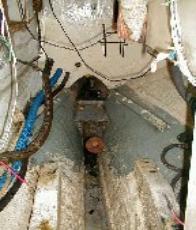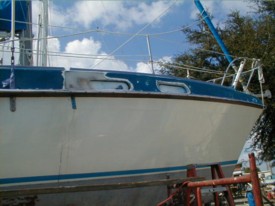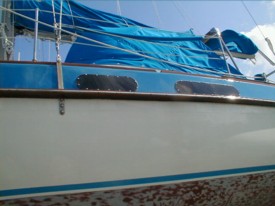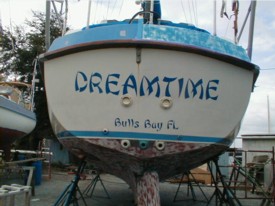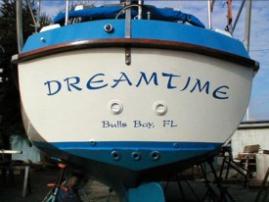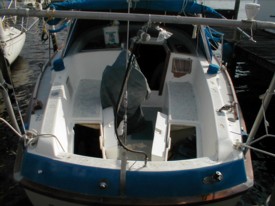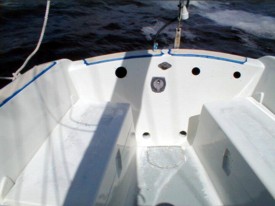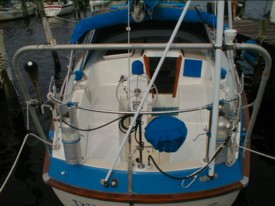| Exterior Projects and Systems |
One of the things that differentiates our Morgan Out Island 33' from others that we have seen is the addition of a
couple of features topsides:
1) A teak deck box, real handy for quick storage.
2) The replacement of the standard molded forward hatch with a raised teak hatch box. A Bomar hatch is mounted on
the top of the box . This raised approach provides extra protection from spray or waves taken over the bow. (That
would never happen!)
couple of features topsides:
1) A teak deck box, real handy for quick storage.
2) The replacement of the standard molded forward hatch with a raised teak hatch box. A Bomar hatch is mounted on
the top of the box . This raised approach provides extra protection from spray or waves taken over the bow. (That
would never happen!)

| Topside Deck Features |

Rub Rail with Stainless Strip - July, 01

The previous owner had the black rubber rub rail replaced in Venezuela with a
mahogany rub rail. He soon tired of maintaining it, and covered it with epoxy and
leftover bottom paint. We completely refurbished it some years back, however with
our schedules we weren't doing the best job of maintenance ourselves.
This haulout we tackled the job. It started with it's complete stripping (using a heat
gun and scraper) and sanding, then finished it with 3 coats of Cetol marine and 3 coats
of Cetol clear. Wow! Looks fabulous and glossy. To protect it we installed a stainless
steel strip.
See the few shots below for a taste of the manual labor involved.
I learned that a heat gun really lifts old finish pretty effortlessly, relatively speaking. I
was able to scrape off all the old cetol down to bare wood after a 30 second blast of
the heat gun. Pretty cool.
mahogany rub rail. He soon tired of maintaining it, and covered it with epoxy and
leftover bottom paint. We completely refurbished it some years back, however with
our schedules we weren't doing the best job of maintenance ourselves.
This haulout we tackled the job. It started with it's complete stripping (using a heat
gun and scraper) and sanding, then finished it with 3 coats of Cetol marine and 3 coats
of Cetol clear. Wow! Looks fabulous and glossy. To protect it we installed a stainless
steel strip.
See the few shots below for a taste of the manual labor involved.
I learned that a heat gun really lifts old finish pretty effortlessly, relatively speaking. I
was able to scrape off all the old cetol down to bare wood after a 30 second blast of
the heat gun. Pretty cool.


Companionway Coaming Area - Aug, 02
The deck paint was very tired. In late '02 we undertook the process of sanding, primering, painting and applying treadmaster to
our deck surfaces starting first in the cockpit coaming area.
The previous owner must have used incompatible paint on top of the existing painted surfaces as small rust colored bubbles
are apparent when sanding. We have decided to sand down to bare gelcoat. This is somewhat TEDIOUS to say the least, but
perseverance pays, and we have one set of before and after shots to show for our troubles so far. Needless to say, we have a
ways to go.
Additionally, the companionway slide had worn channels down into the fiberglass which caused misalignment when pulled
forward onto the slat boards. We used epoxy (with filler) and aluminum strips to rebuild that area. The before shot shows the
grooves in the fiberglass, plus the aluminum strips needed to repair it. The after shot was taken after the rebuild process is
complete, along with the paint, the reinstallation of the companionway hatch, the teak rails and treadmaster.
We removed the teak rails that guide the companionway slide so that we could easily take out the hatch and repaint it with
2-part while we were at it. The after shot shows the area all put back together.
our deck surfaces starting first in the cockpit coaming area.
The previous owner must have used incompatible paint on top of the existing painted surfaces as small rust colored bubbles
are apparent when sanding. We have decided to sand down to bare gelcoat. This is somewhat TEDIOUS to say the least, but
perseverance pays, and we have one set of before and after shots to show for our troubles so far. Needless to say, we have a
ways to go.
Additionally, the companionway slide had worn channels down into the fiberglass which caused misalignment when pulled
forward onto the slat boards. We used epoxy (with filler) and aluminum strips to rebuild that area. The before shot shows the
grooves in the fiberglass, plus the aluminum strips needed to repair it. The after shot was taken after the rebuild process is
complete, along with the paint, the reinstallation of the companionway hatch, the teak rails and treadmaster.
We removed the teak rails that guide the companionway slide so that we could easily take out the hatch and repaint it with
2-part while we were at it. The after shot shows the area all put back together.

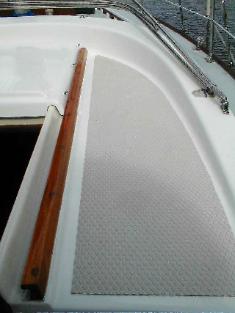
Before all the hard work
After all the hard work
New Electronics Project - Triducer - Jan, 03
The 2002 winter haul-out batch of projects included the installation of a new triducer which feeds sonar, speed
through the water, and temperature data back to the Lowrance unit.
Here is a shot of the transducer plus the mahogany fairing block the Capt'n had to make to get a level
installation through the hull.
through the water, and temperature data back to the Lowrance unit.
Here is a shot of the transducer plus the mahogany fairing block the Capt'n had to make to get a level
installation through the hull.
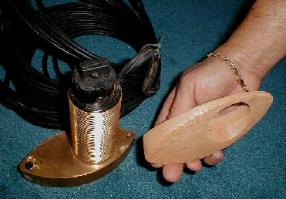
| Replacement Portlights/Paint/Transom Makeover - Nov, 03 |
One of the things we wanted to work on after the spring shakedown cruise was the replacement of the plexiglas portlights. They had
suffered from a lot of UV damage and were difficult to see through.
While we were at it we decided to repaint the blue between the toe and rub rails. Had to do a fiberglass repair where the old owner had
made a bondo-type patch to fair out a mishap!
Click each picture for a larger view
suffered from a lot of UV damage and were difficult to see through.
While we were at it we decided to repaint the blue between the toe and rub rails. Had to do a fiberglass repair where the old owner had
made a bondo-type patch to fair out a mishap!
Click each picture for a larger view
| Before, sadly in need |
| After |
We also decided to perform a makeover on the transom, which was dated and tired. During this makeover we decided to beef-up the
cockpit drainage by installing a couple of 3" scuppers. Our cockpit is huge and the 1" drain in the bottom of the cockpit just didn't seem
like it would handle any serious green water that might make it in. We have plugs which fit into the scuppers to keep any following seas (or
swimming critters) out. These are tied together and come out with a mighty pull when ready to be called into action (that hasn't happened
yet but we're glad to have them).
In addition to the scuppers the makeover included sanding, repainting and relettering while we had the boat in the yard. We also rounded
up a new font from the web (called Kudasai) and found a shop that would take the TTF file and cut the new vinyl lettering accordingly. Looks
a dream now! I love it!
cockpit drainage by installing a couple of 3" scuppers. Our cockpit is huge and the 1" drain in the bottom of the cockpit just didn't seem
like it would handle any serious green water that might make it in. We have plugs which fit into the scuppers to keep any following seas (or
swimming critters) out. These are tied together and come out with a mighty pull when ready to be called into action (that hasn't happened
yet but we're glad to have them).
In addition to the scuppers the makeover included sanding, repainting and relettering while we had the boat in the yard. We also rounded
up a new font from the web (called Kudasai) and found a shop that would take the TTF file and cut the new vinyl lettering accordingly. Looks
a dream now! I love it!
| Before |
| After |
| Cockpit Paint and Treadmaster - May, 04 |
This project had been a loooong time in the process. With the addition of the new electronics, the Capt'n decided to glass in an
opening for the Lowrance unit. This would effectively replace the old holes where the Datamarine gauges were removed. And what an
excellent job he did!
We felt that the whole key to a successful outcome of this project was minutely detailed preparation work. That meant weeks of
grinding down to gelcoat, fairing, and sanding to get a smooth surface with all stress cracks filled and faired. We removed all the
hardware, including the stern rail, winch drums, cleats, and various other doodads.
After we were satisfied with the results, we applied 2 coats of primer, which we then sanded heavily. 2 more coats of primer with
another sanding and we were ready for the Awlgrip application. For that, we got help from our Green Cove Springs painter, Reggie,
who did a stellar roll & tip job on it.
Next it was mask off and repaint our non-skid areas on top of the transom and cockpit coaming. We are switching from gray to tan, and
eventually the entire deck was made to meet these color changes.
Then make patterns for the cockpit seat tops and cut and fit the treadmaster. Masking around the treadmaster's footprint, we sanded
inside the taped area to ensure good adhesion for the thickened epoxy. Finally, installed the treadmaster and removed the tape. As
the final step we painted non-skid on the floor. Click each picture for a larger view
opening for the Lowrance unit. This would effectively replace the old holes where the Datamarine gauges were removed. And what an
excellent job he did!
We felt that the whole key to a successful outcome of this project was minutely detailed preparation work. That meant weeks of
grinding down to gelcoat, fairing, and sanding to get a smooth surface with all stress cracks filled and faired. We removed all the
hardware, including the stern rail, winch drums, cleats, and various other doodads.
After we were satisfied with the results, we applied 2 coats of primer, which we then sanded heavily. 2 more coats of primer with
another sanding and we were ready for the Awlgrip application. For that, we got help from our Green Cove Springs painter, Reggie,
who did a stellar roll & tip job on it.
Next it was mask off and repaint our non-skid areas on top of the transom and cockpit coaming. We are switching from gray to tan, and
eventually the entire deck was made to meet these color changes.
Then make patterns for the cockpit seat tops and cut and fit the treadmaster. Masking around the treadmaster's footprint, we sanded
inside the taped area to ensure good adhesion for the thickened epoxy. Finally, installed the treadmaster and removed the tape. As
the final step we painted non-skid on the floor. Click each picture for a larger view
| Cockpit lazarette doors off and electronics bay roughed in |
Stress cracks were terminated with the drill and
walled out with the Dremel prior to filling with
epoxy. Then of course you must sand smooth.
walled out with the Dremel prior to filling with
epoxy. Then of course you must sand smooth.
Cockpit is painted, now to the non-skid
Treadmaster is installed, floor already painted
The voila shot shows the completed project. Check out
the sunbrella cover for the electronics bay to the right
of the companionway.
the sunbrella cover for the electronics bay to the right
of the companionway.
Good shot of starboard side including electronics
bay but treadmaster is still taped off.
bay but treadmaster is still taped off.
Battery Compartment Upgrade - Feb, 03
All cruisers strive to be energy efficient and depend on
the house batteries to power all the 12vt goodies.
Therefore, the battery system is generally on the list of
systems to upgrade. We did quite a bit more than just
change out the batteries, and have a page to prove it!
Click on this link to check it out.
the house batteries to power all the 12vt goodies.
Therefore, the battery system is generally on the list of
systems to upgrade. We did quite a bit more than just
change out the batteries, and have a page to prove it!
Click on this link to check it out.
| Before |
| After |
New Electronics Bay for Lowrance - May, 04
As a part of the cockpit makeover, Ed decided to glass in a new electronics bay for the Lowrance to get rid of the obsolete
Datamarine electronics openings. He envisioned a glassed-in box opening with provisions for a plexiglas cover that would either
slide longways covering the entire bay (for rain protection and while not in use), or slide in horizontally and thus stick out providing
a platform for a shade cover.
We have installed Ram Mounts for use with the Chart Plotter and the Radar. This seemed a lot more safe and sensible to us as we
can remove those (expensive) electronics from harm's way and casual thievery when in port or up on the hard. The Chart Plotter's
ram mount is situated inside the cabin hanging from the headliner. The Lowrance is always below decks and just "pokes" it's head
out through the new opening. The Radar has 2 mounts; one is topsides and is in use while making overnight or foggy passages,
while the 2nd one is below decks, also hanging from the headliner (all are through-bolted for stability). This secondary mount lets
us position the radar below decks for use alongside the chart plotter while at anchor during a storm. We sat out Hurricane Wilma in
a protected anchorage and maintained a more than adequate anchor watch with both units on assisting us. We would stick our
heads up every 15 minutes for a 360-degree visual sighting but relied on the GPS track plotter zoomed into a micro-level and the
radar display in between sightings. This setup has also proven effective on offshore passages where visibility is nil due to weather
(driving rain/fog) or overnight conditions (driving rain). The data between the 2 systems can be compared and serve as a sanity
check for each other.
Ed started by cutting the new opening, then he had to cut a "blank" from the fiberglass he removed for the main opening to plug
the lower Datamarine instrument hole left behind by it's removal. He then cut, epoxied and fiberglassed balsa wood strips which
would act as guides for the plexiglas protective cover. Meanwhile, he cut the plexiglas cover and shaped it using a heat gun.
After lots of fairing it was ready to be primered and painted. We also have a heavy-duty, gasketted plexiglas cover which is
battened from the inside to use in port or in storm situations.
Datamarine electronics openings. He envisioned a glassed-in box opening with provisions for a plexiglas cover that would either
slide longways covering the entire bay (for rain protection and while not in use), or slide in horizontally and thus stick out providing
a platform for a shade cover.
We have installed Ram Mounts for use with the Chart Plotter and the Radar. This seemed a lot more safe and sensible to us as we
can remove those (expensive) electronics from harm's way and casual thievery when in port or up on the hard. The Chart Plotter's
ram mount is situated inside the cabin hanging from the headliner. The Lowrance is always below decks and just "pokes" it's head
out through the new opening. The Radar has 2 mounts; one is topsides and is in use while making overnight or foggy passages,
while the 2nd one is below decks, also hanging from the headliner (all are through-bolted for stability). This secondary mount lets
us position the radar below decks for use alongside the chart plotter while at anchor during a storm. We sat out Hurricane Wilma in
a protected anchorage and maintained a more than adequate anchor watch with both units on assisting us. We would stick our
heads up every 15 minutes for a 360-degree visual sighting but relied on the GPS track plotter zoomed into a micro-level and the
radar display in between sightings. This setup has also proven effective on offshore passages where visibility is nil due to weather
(driving rain/fog) or overnight conditions (driving rain). The data between the 2 systems can be compared and serve as a sanity
check for each other.
Ed started by cutting the new opening, then he had to cut a "blank" from the fiberglass he removed for the main opening to plug
the lower Datamarine instrument hole left behind by it's removal. He then cut, epoxied and fiberglassed balsa wood strips which
would act as guides for the plexiglas protective cover. Meanwhile, he cut the plexiglas cover and shaped it using a heat gun.
After lots of fairing it was ready to be primered and painted. We also have a heavy-duty, gasketted plexiglas cover which is
battened from the inside to use in port or in storm situations.
The voila shot
Aluminum strips in and teak
rails being reinstalled
rails being reinstalled
The voila shot






| Lowrance on it's mount below and poking out of the bay opening. With the Ram Mount we can swivel the unit within the confines of the opening to achieve optimum viewing based upon where the watch person is sitting. |
| With the cushion off, you can see the snaps that hold the cushion in place and the plexiglas blank battened in from below. |
| This is a sunbrella-covered, closed cell foam cushion I made that snaps in place and provides some camouflage for the bay when not in use. |
| The clear insert being slipped into place. We use it like this when it's sprinkling or there's sea spray. |
| Insert goes in horizontally to provide a platform for the sunshade. |
| While making night passages we use the sun shade down (as pictured) to help preserve our night vision. It also doubles as a dust shield and UV protection when the cushion is not in place. |
| Sun shade is deployed to shade the screen from glare when conditions warrant. |
Roughing it in
| (New Pics Added) |
| Rigid Vinyl Rubrail & Paint - April, '17 |
For the past 3 years we have been trying to get someone in Puerto Del Rey interested in taking on the replacement of our 20+ yr old,
half-rotted mahogany rubrails to no avail. Apparently, they have bigger fish to fry, so we decided to make it a DIY project down in St.
Martin where labor and parts are more readily available.
Anyway, since it was breezing and choppy in the lagoon, and we needed a place to chisel off the old rubrail before going into the yard,
we took a mooring way up in a corner by the swing bridge known as the rainbow bridge. Ed worked really hard prying, beating,
screwing, chiseling then bagging up the scraps and taking them for proper disposal but finally, over the course of about 10 days, it was
off. Next step was a haul out at the Time Out Boat Yard in St. Martin and to get started. Since we had to sand and fair the old epoxy and
5200 off the immediate rubrail area we decided to repaint the wide blue area too and so we got some help with the labor from Jonathan.
Eventually we were ready for "Jay" to come and paint and he did such a great job we had him do the boot stripe too.
half-rotted mahogany rubrails to no avail. Apparently, they have bigger fish to fry, so we decided to make it a DIY project down in St.
Martin where labor and parts are more readily available.
Anyway, since it was breezing and choppy in the lagoon, and we needed a place to chisel off the old rubrail before going into the yard,
we took a mooring way up in a corner by the swing bridge known as the rainbow bridge. Ed worked really hard prying, beating,
screwing, chiseling then bagging up the scraps and taking them for proper disposal but finally, over the course of about 10 days, it was
off. Next step was a haul out at the Time Out Boat Yard in St. Martin and to get started. Since we had to sand and fair the old epoxy and
5200 off the immediate rubrail area we decided to repaint the wide blue area too and so we got some help with the labor from Jonathan.
Eventually we were ready for "Jay" to come and paint and he did such a great job we had him do the boot stripe too.
| SIDE NOTE: Once upon a time circa 2003, mahogany rubrail looks great, now though, rotten wood is apparent on stern rubrail, despite hundreds of hours maintaining it over the years. Mahogany rotted from the inside out due to fresh water encroachment. |
| Blue stripe and rubrail area sanded, ports taped over for painting, thanks for your help Jon! |
Ed and Jon work with fitting the rubrail (Taco #V21-9647), using calipers and trial fitting to determine where the hull joint needed a bit of grinding to
ensure a snug, flat fit. The rigid vinyl rubrail sections were 20' long and heavy (for me anyways). We ordered them in via Island Water World (thanks
Rene). We used Lexel to bed the rails and every 12" a stainless steel screw.
What a great project, and great to do ourselves so we can be sure it was done properly! Other projects included reinforcing the dinghy davit bases
with epoxy prior to painting, adding midship cleats, replacing our entire battery bank and a few things I probably can't think of right now.
ensure a snug, flat fit. The rigid vinyl rubrail sections were 20' long and heavy (for me anyways). We ordered them in via Island Water World (thanks
Rene). We used Lexel to bed the rails and every 12" a stainless steel screw.
What a great project, and great to do ourselves so we can be sure it was done properly! Other projects included reinforcing the dinghy davit bases
with epoxy prior to painting, adding midship cleats, replacing our entire battery bank and a few things I probably can't think of right now.
| Jay works on the primer prior to the paint. We went with Awlgrip "Navy Blue" rather than the original color circa 2003 - "Marlin Blue" |
| Ed uses calipers to measure the hull joint. |
Still on the hard at TOBY with Jon doing the bottom paint then finally we are splashed and back on anchor again first in the lagoon then in the USVI.
Dreamtime is a beautiful girl again and we are very happy with the results of our labors. Custom Fit Marine was great to work with and we appreciated all
their help.
Dreamtime is a beautiful girl again and we are very happy with the results of our labors. Custom Fit Marine was great to work with and we appreciated all
their help.
| Ed and Jon trial fit prior to attachment |
